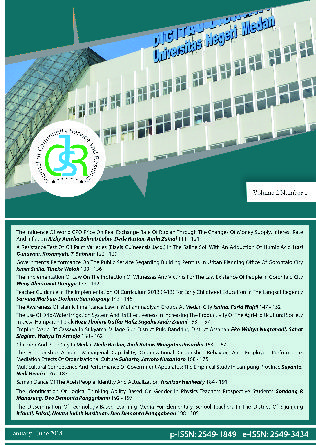A RESISTANCE TEST OF OIL PALM VARIETIES (ELAEIS GUINEENSIS JACQ.) IN THE SALINE SOIL WITH AN ADDUCTION OF HUMIC ACID
DOI:
https://doi.org/10.24114/jcrs.v2i1.9550Abstract
Abstract The objective of the research was to determine theoil palm variety with saline resistance and identify the effective humic acid application dosage with a different salinity rate. This research was conducted in Percut Village.The method used was Randomized Block Design Factorial with 3 factors applied in to 6 varieties oil palm, humic acid dosage (3 dosages) and salinity rate (3 rate) with 3 replications. The results of this research showed that the salinity rate affected significantly to oil palm morphology in saline soil with humic acid adduction. In S0 (0 mmhos), Yangambi variety can increase oil palm plant height, number of leaves, root volume and dry weight of roots. Keywords : Humic Acid, Oil Palm, Saline, VarietyAbstract The objective of the research was to determine the oil palm variety with saline resistance and identifythe effective humic acid application dosage with a different salinity rate. This research was conductedin Percut Village. The method used was Randomized Block Design Factorial with 3 factors applied into 6 varieties oil palm, humic acid dosage (3 dosages) and salinity rate (3 rate) with 3 replications.The results of this research showed that the salinity rate affected significantly to oil palm morphologyin saline soil with humic acid adduction. In S0 (0 mmhos), Yangambi variety can increase oil palmplant height, number of leaves, root volume and dry weight of roots.Keywords : Humic Acid, Oil Palm, Saline, VarietyDownloads
Published
2018-04-25
Issue
Section
Articles
License
Authors who publish with this journal agree to the following terms:
- Authors retain copyright and grant the journal right of first publication with the work simultaneously licensed under a Creative Commons Attribution License that allows others to share the work with an acknowledgment of the work's authorship and initial publication in this journal.
- Authors are able to enter into separate, additional contractual arrangements for the non-exclusive distribution of the journal's published version of the work (e.g., post it to an institutional repository or publish it in a book), with an acknowledgment of its initial publication in this journal.
- Authors are permitted and encouraged to post their work online (e.g., in institutional repositories or on their website) prior to and during the submission process, as it can lead to productive exchanges, as well as earlier and greater citation of published work (See The Effect of Open Access).
- This work is licensed under a Creative Commons Attribution-ShareAlike 4.0 International License.
This work is licensed under a Creative Commons Attribution-ShareAlike 4.0 International License.


